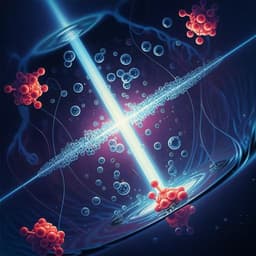
Engineering and Technology
A Ta-TaS₂ monolith catalyst with robust and metallic interface for superior hydrogen evolution
Q. Yu, Z. Zhang, et al.
Discover groundbreaking advancements in green hydrogen production! This research presents a tantalum sulfide monolith catalyst that outperforms traditional noble metals, achieving remarkable durability and rapid charge transfer. Conducted by a team of experts, this study opens new avenues for efficient hydrogen evolution.
~3 min • Beginner • English
Introduction
The paper addresses the challenge of achieving industrially relevant hydrogen evolution reaction (HER) performance—high current densities (up to ~2000 mA cm⁻²) with stability and low overpotential—while reducing reliance on scarce and expensive noble metals (Pt, Ir). Conventional electrodes rely on catalysts attached to conductive substrates with binders (e.g., Nafion), which leads to weak adhesion, catalyst peel-off at high currents, and significant interfacial resistance, causing poor stability and Joule heating. Even direct growth of catalysts on substrates often leaves van der Waals or ionic interfaces that still impose resistance. The research question is how to design a catalyst–substrate architecture that delivers near-zero interfacial resistance and strong mechanical bonding to enable efficient and durable HER at large current density. The authors propose a monolith catalyst (MC) architecture where a metallic TMDC (e.g., TaS₂) is vertically grown from the parent metal (Ta), forming covalent Ta–S bonds and eliminating the van der Waals gap, to provide unimpeded charge transfer and robust mechanical integrity.
Literature Review
The introduction surveys limitations of current HER technologies and catalysts: PEM electrolyzers can reach high current densities (~2000 mA cm⁻²) but face stability, cost, and efficiency challenges. Industrial catalysts based on Pt and Ir are scarce and degrade under large currents. Strategies to reduce noble-metal usage (alloys, clusters, single atoms) still depend on binders and suffer from weak adhesion and increased interfacial resistance. Prior work has shown substrate-catalyst interactions and electronic coupling can influence HER activity in 2D TMDCs (e.g., MoS₂, TaS₂). However, catalyst peel-off and interface resistance remain problematic, especially at large currents. Direct growth techniques improve adhesion but often maintain van der Waals/ionic interfaces that impede electron transport. These insights motivate a fundamentally different interface design—creating a monolithic, covalently bonded catalyst-substrate system to minimize resistance and maximize robustness.
Methodology
Synthesis (Oriented-Solid-Phase Synthesis, OSPS):
- Metals (Ta, Nb, Mo; 99.95%) and sulfur (99.0%) were used. Ta foil (typical 1×1×1 cm) was laser-patterned (355 nm, 1–1000 µm beam, ~10⁷ W cm⁻²) to create tunable pore sizes (5–1000 µm), then ultrasonically cleaned.
- Pre-oxidation in air created metal oxides: Ta₂O₅ (Ta at 500 °C, 15 min), MoO₃ (300 °C), Nb₂O₅ (430 °C).
- Sulfurization in a tube furnace: oxides and S placed in separate zones (Ta₂O₅ at 900 °C; S at 180 °C; for MoO₃ 750 °C, Nb₂O₅ 850 °C). Chamber evacuated to 0.05 Torr, flushed with Ar twice. Growth under Ar/H₂: ramp under Ar 95 sccm/H₂ 5 sccm, then 3 h at Ar 85 sccm/H₂ 15 sccm. Slow cool in Ar 100 sccm. Sulfur diffuses into TaO₂ converting it to TaS₂ while underlying Ta remains, forming vertically bonded Ta–TaS₂ MC.
- Electrochemical treatment: Three-electrode cell (graphite counter, saturated Ag/AgCl reference, MC working). Cyclic voltammetry between +0.10 and −0.50 V vs RHE at 50 mV s⁻¹ for up to 15,000 cycles to exfoliate and create porosity; best performance after 15,000 cycles.
Characterization:
- XRD (D8 Advance, Cu Kα, 10°–80° 2θ) confirmed 3R-TaS₂ phase (peaks at 14.9° (003), 32.2° (101), 55.1° (110)). Raman (532 nm) supported phase identification.
- XPS (PHI 5000 Versa Probe II): Ta 4f peaks (Ta⁴⁺ in 3R-TaS₂ at 23.3, 25.2 eV; tantalum oxide at 26.5, 27.2 eV); S 2p at 161.9/162.9 eV for S²⁻ in 3R-TaS₂.
- Electron microscopy: SEM (HITACHI SU8010), TEM (FEI Tecnai F30, 200 kV). Cross-section HRTEM showed 0.63 nm interplanar spacing matching 3R-TaS₂ (003). STEM-HAADF with EDS mapping showed sharp TaS₂/Ta interface and S only on the TaS₂ side.
- Mechanical testing: adhesive strength via an electrical universal tester (MTS C45.105); force–displacement used to determine critical load.
- Electrical conductivity: measured via probe station/semiconductor analyzer (SCS 4200).
- Wettability: contact angles measured; Ta foil ~91.4°, Ta-TaS₂ MC ~0°.
Electrochemical testing:
- Three-electrode setup (graphite counter, saturated Ag/AgCl reference, MC as working) in 0.5 M H₂SO₄. Potentials converted to RHE: E(RHE) = E(Ag/AgCl) + 0.201 V.
- Electrode geometric area: 1×1 cm² for current density normalization.
- LSV: 2 mV s⁻¹ (HER activity), with small iR-compensation. Additional LSV at 0.5 mV s⁻¹ for calibration.
- EIS: Nyquist at η = 50 mV, frequency 1 MHz to 0.1 Hz.
- Stability: chronoamperometry at 200, 500, 1000 mA cm⁻²; cycling up to 20,000 cycles.
- Δη/Δlog|j| used to evaluate performance across current ranges.
Overall water electrolysis (two-electrode):
- Ta-TaS₂ MC cathode paired with commercial IrO₂ anode in a home-made cell; V–I curves and durability at 500 and 1000 mA cm⁻²; gas collection to assess Faradaic efficiency.
Computational methods:
- Spin-polarized DFT with PBE-GGA and PAW (VASP). Energy and force convergence 10⁻⁴ eV and 0.02 eV Å⁻¹; plane-wave cutoff 450 eV; D3 dispersion. k-point mesh 3×3×1 Γ-centered. Valence: Ta (5d³6s²), S (3s²3p⁴). Band structures, hydrogen adsorption free energy (G_H), and interface separation energies computed for models of Ta/TaS₂ (parallel) and Ta–TaS₂ MC (vertical).
Key Findings
- Monolith catalyst architecture: Vertically grown metallic TaS₂ on Ta (Ta–TaS₂ MC) forms covalent Ta–S bonds without a van der Waals gap, enabling near-zero interfacial resistance and strong adhesion.
- Theoretical insights: Ta–TaS₂ MC shows hydrogen adsorption free energy G_H ≈ 0.10 eV (close to Pt), vs TaS₂ alone ≈ 0.61 eV; band structure indicates metallic interface with dispersive states crossing Fermi level. Interface separation energy ΔE much larger for vertical Ta–TaS₂ MC (10.56 eV) vs parallel Ta/TaS₂ (0.37 eV), indicating stronger bonding.
- Structural characterization: 3R-TaS₂ phase confirmed by XRD and Raman; HRTEM interplanar spacing 0.63 nm (003 plane). STEM-EDS shows sharp TaS₂/Ta interface.
- Mechanical robustness: Adhesive strength measured at 39.9 N/mm² for Ta–TaS₂ MC, >3× that of Ta/TaS₂ (12.3 N/mm²) and Pt/C on glassy carbon (13.4 N/mm²).
- Electrical conductivity: ~3×10⁶ S/m for Ta–TaS₂ MC, comparable to metals (Pt, Ir, Ta), orders of magnitude higher than graphite, semiconducting MoS₂, and oxides.
- Wettability: Contact angle ~0° for Ta–TaS₂ MC vs 91.4° for Ta foil, aiding mass transfer.
- HER activity (0.5 M H₂SO₄):
• Achieves 2000 mA cm⁻² at an overpotential of 398 mV.
• Outperforms Ta/TaS₂ composite (607 mA cm⁻² at 398 mV) and porous Pt foil (η = 740 mV to reach 2000 mA cm⁻²).
• Δη/Δlog|j| remains low: ~30 mV dec⁻¹ at small currents; ~58 mV dec⁻¹ in the 10²–10³ mA cm⁻² range (porous Pt rises to ~90 mV dec⁻¹).
• At 10 mA cm⁻², overpotential comparable to Pt, indicating high intrinsic activity.
• Charge transfer resistance (EIS) as low as 3.2 Ω at η = 50 mV, vs 9.0 Ω for TaS₂.
- Durability: Negligible performance decay over 200 h at 1000 mA cm⁻² (acid electrolyte); stable over 20,000 CV cycles with no notable change in polarization curves, XPS, or XRD.
- Generality: Similar performance advantages observed for Nb–NbS₂ and Mo–MoS₂ MCs over their composite counterparts.
- Overall water electrolysis (two-electrode): Ta–TaS₂ MC cathode || IrO₂ anode reaches 1000 mA cm⁻² at 1.98 V (better than porous Pt foil || IrO₂ at 2.20 V). Faradaic efficiency ~100% (H₂ amount matches theoretical; H₂:O₂ ≈ 2:1). Stable operation for >24 h at 500 and 1000 mA cm⁻².
- Scalability and cost: MC synthesized over 35 cm² area (size limited by furnace diameter) with uniform morphology. Ta/Nb are 2–3 orders of magnitude cheaper and 1–3 orders more abundant than Pt, highlighting cost advantages.
- Benchmarking: At η = 300 mV, Ta–TaS₂ MC delivers 1120 mA cm⁻², outperforming many state-of-the-art HER catalysts surveyed.
Discussion
The findings demonstrate that engineering a monolithic, covalently bonded catalyst–substrate interface directly addresses the key bottlenecks in large-current-density HER: interfacial electron transport and mechanical stability. The Ta–TaS₂ MC architecture eliminates the van der Waals gap and minimizes interfacial resistance, enabling rapid electron injection to active sites and reduced Joule heating under high currents. Simultaneously, the strong Ta–S bonding yields high adhesive strength, preventing catalyst detachment during vigorous gas evolution. These properties translate into superior catalytic metrics—low overpotentials to reach industrial currents (e.g., 398 mV at 2000 mA cm⁻²), low Δη/Δlog|j| at high currents, low charge transfer resistance, excellent wettability, and long operational stability in acid. The approach is generalizable across TMDCs (NbS₂, MoS₂) and scales to sizable electrodes with uniform performance. In practical two-electrode electrolysis, the MC cathode paired with IrO₂ anode achieves high current densities at lower cell voltages than commercial porous Pt, with near-100% Faradaic efficiency, underscoring its relevance for industrial electrolyzers.
Conclusion
This work introduces a monolith catalyst design—vertically grown metallic TMDCs (e.g., TaS₂) covalently bonded to their parent metal substrates (Ta)—that provides a robust, metallic interface with near-zero interfacial resistance. The Ta–TaS₂ MC achieves 2000 mA cm⁻² at an overpotential of 398 mV and sustains large-current-density operation for 200 h in acidic electrolyte, outperforming conventional Pt-based electrodes especially at high currents. The architecture scales to large areas and, when integrated in a two-electrode cell with IrO₂, delivers 1000 mA cm⁻² at 1.98 V with ~100% Faradaic efficiency and excellent durability. Given the lower cost and higher abundance of Ta/Nb compared to Pt, and the demonstrated extension to Nb–NbS₂ and Mo–MoS₂, this monolith strategy offers a promising route toward industrial HER electrodes. Future work could extend this approach to other metals/chalcogenides and reactions (e.g., other electrocatalytic processes), optimize porosity and mass transport, and integrate into full PEM/alkaline electrolyzer systems for long-term, large-scale validation.
Limitations
The demonstrated large-area electrode size (≈35 cm²) was limited by the furnace diameter used in synthesis. Performance and durability evaluations were conducted primarily in 0.5 M H₂SO₄ and in a home-made two-electrode cell; broader electrolyte conditions and larger-scale, longer-duration device tests were not reported.
Related Publications
Explore these studies to deepen your understanding of the subject.







